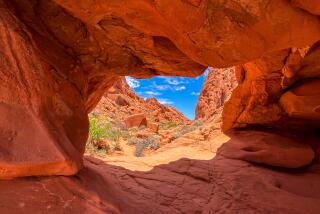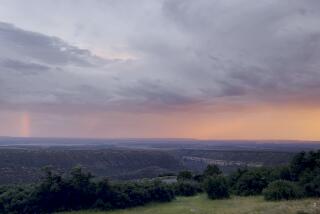Desert discoveries
DESERT NORTH OF FAYOUM, Egypt — Gesturing with both arms spread wide, desert guide Amr Shannon seems to embrace both the patch of sand where he’s chosen to spend the night and the view it commands of a purple-blue Lake Fayoum.
“Isn’t it wonderful? Don’t we have a wonderful terrace?” he says, then shoos his clients off to explore Henry Mooresque rock formations while he sets up the tents and a camp kitchen complete with portable sink and two gas-fired burners.
Thanks to such service, a tour of Egypt’s Western Desert can be a family adventure. Mom or Dad need only worry about driving, and the kids are sure to be thrilled by the roller-coaster off-road ride in a four-wheel-drive. Careening over washboard tracks left by flash floods, launching briefly into the air over sudden rises, threading though cliff passes. It’s easier, and a lot more fun than it sounds, though getting mired in soft sand is a possibility.
Adults could find themselves acting like children at another camp site deeper into the desert, this one sheltered by sand dunes. The pleasures of scampering barefoot up the warm sand and rolling down are enough to move Shannon to his favorite adjective:
“Dunes are wonderful!”
For the more sedentary, the scenery is absorbing. An expedition of three or four days is enough to include the White Desert, a six-hour, on-road drive southwest of Cairo. Its giant chalk formations look like tombstones in a very postmodern cemetery. The monotony of the desert is made myth: Just watch the colors shift with the day across the chalk outcroppings, from the shadowy gray of predawn through the hot white of noon and on to the spectacular purples of sunset.
Across the desert, the rocks and dunes have been worked by time, wind and sand into voluptuous shapes colored by minerals into yellows, whites, charcoals, and reds ranging from pomegranate to chalky rose. Scattered mica shards reflect the sunlight, gleaming like so many stars against a night of sand.
This being Egypt, history also is scattered across the sands.
Soon after leaving behind Cairo’s outskirts and pulling off the highway, Shannon usually stops at a mysterious pile of broken pottery that the desert winds are slowly stripping of a blanket of sand. Shannon speculates camel caravans discarded the pots here centuries ago as they made their way from Africa to Europe. He can’t say why the ancient traveling salesmen chose this spot to build a mountain of pottery, and no archaeologists have investigated the find.
Farther on, builders of a temple half-finished in antiquity appear to have been frightened off by an earthquake or engineering fault, judging by the cracks and awkward angles of the huge stone blocks. The only clues to the temple’s origins were a few pots found at the site that date it to the Middle Kingdom of the pharaohs, or anywhere from 2055 BC to 1786 BC.
Researchers were lucky to have found those few clay clues. Robbers have taken anything else of value.
Shannon discourages his clients from collecting too many bits of pottery and pretty rocks themselves. The thieves and souvenir hunters could strip Shannon of his livelihood -- desert treasures to show off -- and his love.
“The desert was my father’s passion, and he gave that passion to me,” says Shannon, who first began exploring Egypt’s deserts as a young boy. His camp kitchen includes the salt and pepper shakers fashioned from ink bottles he and his father used on their expeditions.
Today, many fossils have been filched from a favorite spot, the ancient seabed known as the Valley of the Whales. Desert gazelles also have all but disappeared.
But Shannon, who has been a professional desert guide since 1974, would rather point out the delicate tracks in the sand left by wolves and jackals than lament what has been lost.
Desert covers about 90 percent of Egypt’s 386,900 square miles -- an area bigger than Texas split into the Western and Eastern deserts by the Nile and its narrow strip of fertile valley. There’s plenty of room to roam, and it’s still possible to find magical, untouched spots like the Lake Fayoum camp site Shannon stumbled across only a few years ago.
“The desert has changed a lot in 26 years, but there’s still a lot to discover,” he says.
For his clients, much that Shannon takes for granted, like the profound silence of a night on the desert, are a revelation. Under a blue velvet sky salted with stars, newcomers will be left to their own thoughts, and to watch for the occasional falling star.
A good guide will leave you feeling the desert is a gorgeous playground. But it’s a harsh and unforgiving place, and you want a guide who’s prepared. Luxury tour companies often include a few days in the desert in package trips that also take in the pyramids near Cairo and the spectacular temples of southern Egypt. Such trips can set you back several hundred dollars a day, but include all meals; air-conditioned, four-wheel-drive vehicles, and accommodation in plush tents for the desert nights. Among companies offering such trips: Bestway Tours & Safaris in Burnaby, B.C. (604-264-7378; bestway.com); Landmark Adventures in Reno, Nev. (775-345-7540; landmarkadventures.com); and Pan Arab Tours in Cairo (moussa.net/pat/index.htm).
At the other end of the spectrum are cheap outings organized by hotels and guides in oases towns like Dahkla and Bahariya. It’s possible to spend less than $30 for a day in the desert. Many backpackers simply take a bus from Cairo and shop around for the best deal once they reach an oasis. Amr Shannon falls somewhere in between, with a personal touch few can match. For $300 a day he will lead as many as 12 people into the desert. Renting your own four-wheel drive will increase the cost about $120 a day. Shannon provides tents and other camping equipment, you bring the food and do the cooking. Shannon can be reached by e-mail at ashannoninternetegypt.com or by phone on (20-2) 519-6894 or (20-12) 341-7496.
More to Read
Sign up for Essential California
The most important California stories and recommendations in your inbox every morning.
You may occasionally receive promotional content from the Los Angeles Times.










